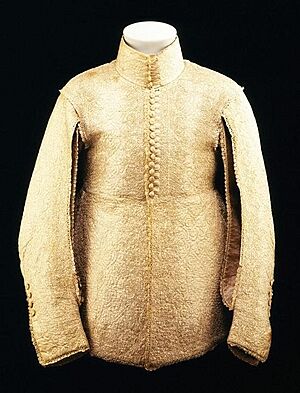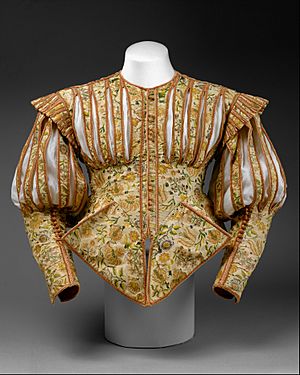Doublet (clothing) facts for kids
A doublet was a type of snug-fitting jacket worn by men. It was popular in Spain and then spread across Western Europe. People wore doublets from the late Middle Ages until the mid-1600s.
This jacket was usually hip-length or waist-length. Men wore it over their shirts or underwear. For a long time, until the late 1400s, doublets were often worn under another piece of clothing. This could be a gown, a cloak, or a jerkin.
The doublet first started as a padded lining. It was worn under armor to stop the armor from rubbing and bruising the body. Over time, the doublet became a stylish item on its own.
For about 300 years, the doublet had a few main jobs. It helped give a fashionable shape to the body. It also had ties to hold up a man's leg coverings, called hose. And, of course, it helped keep the body warm. The only things that really changed about the doublet over time were its style and how it was cut.
Contents
History of the Doublet

The doublet grew out of padded clothing worn under armor. These were similar to items like the gambeson.
Doublets in the 1300s and 1400s
Doublets from the 1300s and 1400s usually reached the hips, or sometimes were even shorter. Men wore them over their shirts and hose. They often wore another outer gown, like a houppelande, on top.
From the late 1300s, doublets were cut and padded to make the wearer's chest look bigger, like an egg or a pigeon. This fashion slowly went out of style. Later, doublets became flatter and fit the body more naturally. In England, a good doublet in the late 1400s was expected to last about two years. However, some people said their doublets fell apart after only four months.
Doublets in the 1500s
During the Tudor period, fashionable doublets stayed close-fitting. They often had puffy sleeves. They also featured fancy decorations. These included small cuts in the fabric called 'pinks', slashes, embroidery, and applied braids.
Men wore their doublets over a shirt. Sometimes, doublets had no sleeves, or they had tight or removable sleeves. They were often made of wool or a rough canvas material called 'kersey'. Until about 1540, doublets had laces. These laces allowed men to tie their hose (leg coverings) to the doublet.
In the early Elizabethan period, doublets were padded over the stomach. This created a "pouter pigeon" or "peascod" shape, which looked like a pea pod. Decorative 'wings' or 'tabs' hid where the sleeves attached at the shoulder. Short, skirt-like flaps called 'peplums' or 'piccadills' covered the waist of the hose or breeches. Over time, this padding became less popular. The doublet then became close-fitting with a deep V-shaped waistline.
In 1590, an African servant at the Scottish court received a special doublet. It was made of shiny, "changing" Spanish taffeta with 48 buttons. In 1600, Elizabeth Brydges, a maid of honor, gave Elizabeth I a doublet as a New Year's gift. It was made of net-like fabric, cut and puffed up with white knit-work and silver decorations.
Doublets in the 1600s
By the 1600s, doublets had a short waist. A common sleeve style from this time was full and slashed. This allowed the shirt underneath to show through. A later style was full and 'paned' (slashed) only to just below the elbow, fitting snugly below that.
Decorative ribbon 'points' were pulled through small holes on the breeches and the doublet's waist. These ribbons helped keep the breeches in place. They were often tied in fancy bows.
James Hay, 1st Earl of Carlisle, once wrote about the very tight costumes worn by performers in English court plays. He said the fashion was "to appear very small in the waist." He remembered being lifted off the ground by two people while a tailor used all his strength to button his doublet.
The doublet finally went out of fashion in the mid-1600s. This happened when Louis XIV of France and Charles II of England introduced a new court outfit for men. This new style included a long coat, a waistcoat, a cravat, a wig, and breeches. This new outfit was the beginning of the modern suit.
Images for kids
-
The tailor in Giovanni Battista Moroni's famous portrait (around 1570) wears a doublet and padded hose.
-
Edward VI in a fancy, long-skirted late Tudor doublet under a red gown.
-
Philip Sidney, an English poet, wearing a doublet.
-
Martin Frobisher in a doublet with a 'peascod' belly, worn under a buff jerkin.
-
Charles I in a doublet and breeches fastened with 'points'. Painting from 1629 by Daniel Mijtens the Elder.
See also
 In Spanish: Jubón para niños
In Spanish: Jubón para niños
- 1500–1550 in fashion
- 1550–1600 in fashion
- 1600–1650 in fashion
- 1650-1700 in fashion
- Brigandine








